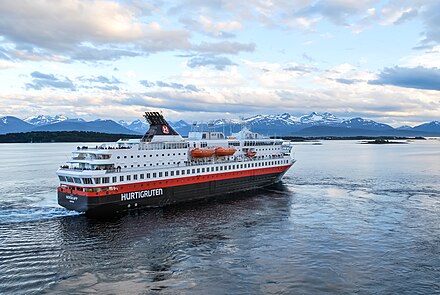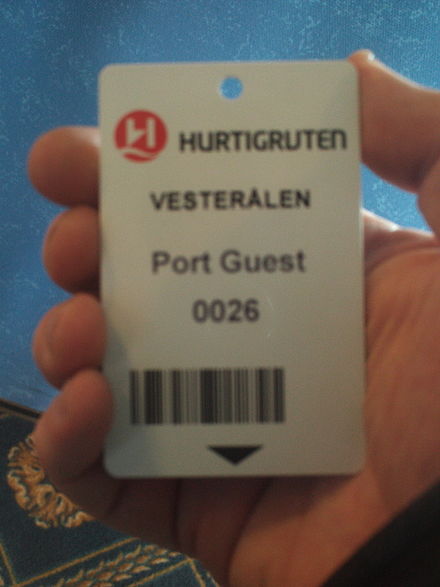Hurtigruten
Hurtigruten
Hurtigruten is a ship route along the Norwegian coast from Bergen to Kirkenes.
Understand
 Hurtigruten (literally meaning The fast route) is a ferry line along Norway's jagged coastline. Marketed as the "world's most beautiful sea voyage", Hurtigruten ships traverse the western side of the Norwegian coast, largely sheltered by islands and skerries. The Hurtigruten coastal ships do not cruise the famous fjords of West Norway. This is a trip to see the coast along a scheduled route, not the fjords, with some transport of vehicles and goods to communities. During the summer season the Hurtigruten makes a detour to Geiranger fjord. In addition, the ship regularly calls at Molde and Trondheim, both cities located on the shores of major fjords.
Hurtigruten (literally meaning The fast route) is a ferry line along Norway's jagged coastline. Marketed as the "world's most beautiful sea voyage", Hurtigruten ships traverse the western side of the Norwegian coast, largely sheltered by islands and skerries. The Hurtigruten coastal ships do not cruise the famous fjords of West Norway. This is a trip to see the coast along a scheduled route, not the fjords, with some transport of vehicles and goods to communities. During the summer season the Hurtigruten makes a detour to Geiranger fjord. In addition, the ship regularly calls at Molde and Trondheim, both cities located on the shores of major fjords.
Hurtigruten began as transportation company for passengers, goods and mail along the coast of Norway in 1893, providing a crucial link for many communities. At the time the system started, it drastically cut down the time for goods or mail to arrive between regions in Central and Northern Norway, and Oslo. The ships still carry some cargo, but today the ships more closely resemble cruise ships than the original coastal steamers.
The voyage is a simple way of combining lodging, eating, and transport. Unlike many other cruise ferries, Hurtigruten is not a place for drinking and partying. A one way trip takes 6-7 days, while the round-trip takes 12. This contrasts with Norway-in-a-Nutshell tours which are 1-3 days. It's also possible to purchase hop-on, hop-off tickets. Port stops vary in length. They can be as short as 5 minutes and up to 5-6 hours.
A museum, including parts and one whole, prior versions of the ship Finnmarken, sits in one port, Stokmarknes, which explains the history of the line.
The livelihood of some of these coastal community ports revolves around the daily arrival and departure of these ships, at all hours of day and night.
Prepare
 Hurtigruten is quite expensive; a full round trip from Bergen to Kirkenes and back will at cheapest cost almost 10,000 Norwegian kroner/person (€1200, USD1600) in the lowest season in a cabin with shared bathroom and without window. The per person price means that there will be many passengers in your party; if you're using the cabin yourself it costs more. If you're travelling in the summer season the price will be doubled, if you want a "nicer" cabin with window, add an additional 30-100% to the price. The best suite in the middle of the summer costs 72,000 kr/person. If you can travel on the shoulder season (April-May; September-October) or off-season (November; February-March), prices are more reasonable. The ships are very clean and anti-social behaviour, noise, etc., are practically non-existent on board.
Hurtigruten is quite expensive; a full round trip from Bergen to Kirkenes and back will at cheapest cost almost 10,000 Norwegian kroner/person (€1200, USD1600) in the lowest season in a cabin with shared bathroom and without window. The per person price means that there will be many passengers in your party; if you're using the cabin yourself it costs more. If you're travelling in the summer season the price will be doubled, if you want a "nicer" cabin with window, add an additional 30-100% to the price. The best suite in the middle of the summer costs 72,000 kr/person. If you can travel on the shoulder season (April-May; September-October) or off-season (November; February-March), prices are more reasonable. The ships are very clean and anti-social behaviour, noise, etc., are practically non-existent on board.
However, there's no need to travel all the way from Bergen to Kirkenes or back; you can book a voyage as short or as long as your time and budget allow. The cost depends on the distance travelled and on your class of cabin. If you would like to cut the cost and you're not staying longer than one night, you can choose to travel without a cabin. Most ships can carry cars (typically 40-50, excepting the two oldest ships). This could make possibilities for an interesting round-trip.
The ships vary widely in size and amenities. Some resemble cruise ships and feature a sauna, workout room, pool and outdoor jacuzzi, whilst others are cosier affairs with less than a hundred cabins but lots of places to cuddle up with a book. Check what your ship offers before you book.
It is possible to leave the ship and visit a town for one day and continue the next day. On some stretches it is possible to use local fast passenger boats or buses as alternative, maybe travel daytime where Hurtigruten goes by night. There are such passenger boats at least Sandnessjøen–Bodø, Bodø–Svolvær, Harstad–Tromsø and Tromsø–Skjervøy.
The dress code on the ship is casual, but remember to bring warm clothes if you want to walk on the deck. In northern Norway the temperatures can sink to +10°C in the middle of the summer, in the winter the temperatures are most likely below 0°C. The wind from the Atlantic and the Arctic Sea will make it even colder.
Get in

Cars
The ships can also transport cars. Some people take advantage of that fact to drive back on the return journey and see the inner fjords along the E6. Other use Hurtigruten as a short distance car ferry. The latter might cost around 1000 kr including passenger tickets. Hurtigruten does not accept motorhomes or caravans, only cars.
Visiting the ship
When the ship is in port it's possible to simply go see what the ship looks like on the inside. Ask the ticket inspector at the counter next to the entrance and you'll be given a temporary "port guest" ticket. You can eat and buy souvenirs on the ship, send a postcard with the ship's stamp, look at the city or town from sun deck and at generally at the interiors of the ship. But do remember to get out of the ship before it leaves, the tickets are scanned whenever embarking and disembarking so you can't simply sneak out in the next port. "Port Guest" tickets are handed back after your visit.
Voyage
Hurtigruten calls at these ports, listed from south to northeast:
- Bergen 📍 — The second largest city in Norway.
- Florø 📍
- Måløy 📍
- Torvik 📍
- Ålesund 📍
- Geiranger 📍 — Norway's most famous fjord (only in summer, 15 Apr-14 Sep)
- Molde 📍
- Kristiansund 📍
- Trondheim 📍 — Norway's third largest city with an impressive cathedral
- Rørvik 📍
- Brønnøysund 📍 — Situated close to the famous mountain Torghatten
- Sandnessjøen 📍
- Nesna 📍
- Ørnes 📍 — The first port North of the Arctic circle.
- Bodø 📍 — the second largest city in northern Norway
- Stamsund 📍 — access to the southwestern Lofoten archipelago
- Svolvær 📍 — access to the northeastern Lofoten archipelago
- Stokmarknes 📍
- Sortland 📍
- Risøyhamn 📍
- Harstad 📍
- Finnsnes 📍
- Tromsø 📍 — the largest city in northern Norway
- Skjervøy 📍 – an archipelago municipality
- Øksfjord 📍
- Hammerfest 📍
- Honningsvåg 📍 — Close to Nordkapp, referred to as the Northernmost point of continental Europe.
- Kjøllefjord 📍
- Mehamn 📍 — the Northernmost Hurtigruten port.
- Berlevåg 📍
- Båtsfjord 📍
- Vardø 📍
- Vadsø 📍
- Kirkenes 📍 — gateway to Russia and Finnish Lapland
Buy
There is a souvenir shop on each ship.
Eat
Aside from the cafeteria the ship's restaurant serves a lavish buffet breakfast (135 kr), lunch (285 kr) and dinner (395 kr).
Stay safe
The ships themselves are very safe and it is unlikely that anything bad will happen on board. The worst you'll have to worry about is sea-sickness as a number of stretches of the route are exposed to the full force of the Atlantic.
Go next
Drive back in a car or some kind of transportation. A full round trip Bergen-Bergen with ship one way, driving one way, would require two weeks. On the other hand, if you sail back as well, you might get to see landscapes and towns that you passed on the outward journey while you were asleep. This will also take two weeks. There are also airports at the end ports of Bergen and Kirkenes from which you can fly on to other destinations.
Related: Norway